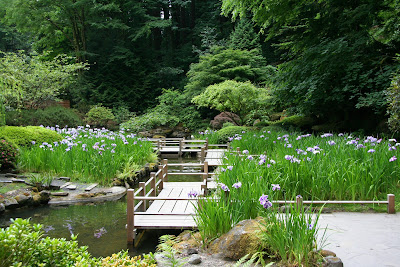The Portland Japanese Garden is said to be the most authentic Japanese Garden outside of Japan. The 5.5 acre garden is located just above the International Rose Test Garden. I've been to a couple of Japanese gardens before, including the Japanese Garden in San Francisco. However, I have never been so moved and transformed by one until I went to this one. It truly gives you a sense of peace and tranquility. I can't explain why or how. It must have to do with the thoughtful layout of the garden areas, the lovingly manicured plants, and the exquisite attention to detail. At the risk of sounding like a real dork, I have to say that it's like walking into a warm embrace. It was a transforming experience for me because I discovered a new-found love of this kind of gardening and a desire to learn more about
it.
 |
| Portland Japanese Garden. |
Each garden area works so well together and you flow from one to another with ease. So much thought went into the various vistas and sneak-peaks you see as you walk through the garden. I think part of what is so fascinating to me about a garden like this is the lack of flowering plants. Of course there are some flowering plants, but it's really about shades of green, shapes of plants, and the texture of leaves. Moss, stone and water are also a big part of the overall garden plan. I have a love of formal English gardens with their clipped boxwood hedges, so I guess it only makes sense that I would like the highly pruned, bonsai-like treatment of the Japanese garden.
 |
| Perfectly manicured shrubs around one of the ponds in the Strolling Pond Garden. |
There are five main garden areas at the Portland Japanese Garden: The Flat Garden, The Strolling Pond Garden, The Tea Garden, The Natural Garden, and The Sand and Stone Garden.
 |
| The waterfall in The Strolling Pond Garden. |
The Flat Garden balances the contrast of the flat, stone-covered ground with meticulously pruned trees and shrubs. Certain features in the garden symbolize the four seasons.
 |
| The Flat Garden. |
The Strolling Pond Garden consists of a few main water features: A circular water garden surrounding by green, clipped shrubs with the Moon Bridge, a wooden bridge that zig-zags through a sea of irises which are reflected in the water below, and a Koi pond with a naturalistic waterfall. Strolling pond gardens such as this were usually reserved for the rich.
 |
| The zig-zag bridge in the Strolling Pond Garden. |
 |
| A close-up of one of the Japanese irises at the zig-zag bridge. |
The Tea Garden was one of Brian's favorite areas. Stepping stones and a bamboo arch lead you along a path that contains carefully placed/shaped stone formations and lanterns. The path (the journey) is an important part of the tea ceremony.
 |
| One of the interesting details in the Tea Garden. |
The Natural Garden contains peaceful, shady areas with carefully planned streams and rocks. Gone are the poofy, manicured shrubs and replacing them are less formal, naturally growing trees and shrubs. There are a few different paths you can take through this area.
 |
| Water leads you through the Natural Garden. |
The Sand and Stone Garden is about "the beauty of blank space." Most people would call this dry landscape a Zen garden because Zen monasteries used this style of gardening for contemplation.
 |
| The Sand and Stone Garden. |
So somehow I have to find a way to incorporate Japanese garden design into my cottage-style flower garden and formal Kitchen Garden. Hmmmm....could be a challenge. But I like challenges.
The Portland Japanese Garden has a really nice website if you want to learn more: http://japanesegarden.com










No comments:
Post a Comment